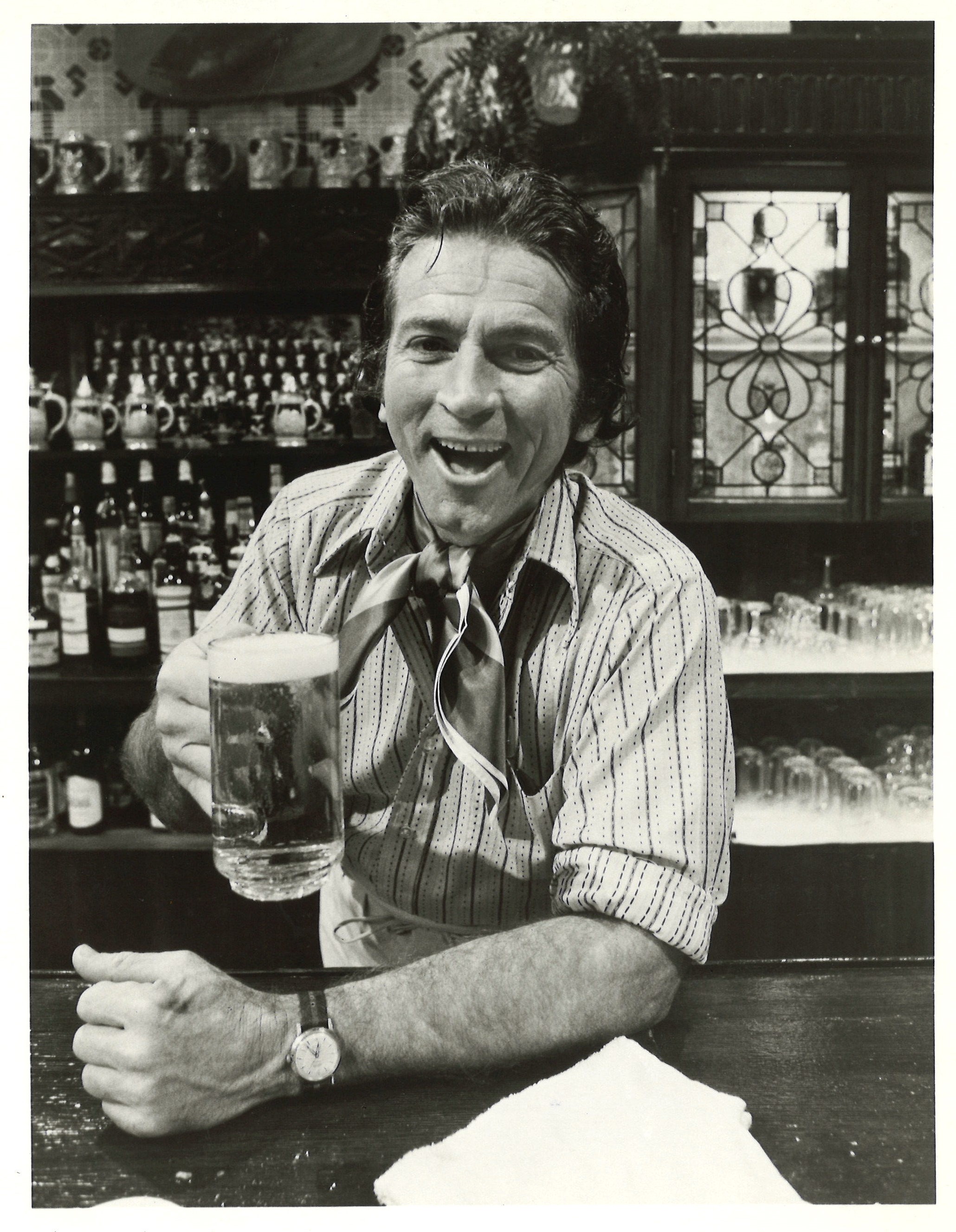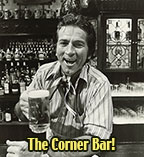THE CORNER BAR 1972-1973 / TVparty! (original) (raw)
By Cary O'Dell
For a series that endured for less than 20 episodes, ABC’s “The Corner Bar” (1972-1973) nevertheless contained a variety of unique, historical elements.
Since the first incarnation of the series (aired in 1972) starred actor Gabriel Dell, who rose to fame as one of the Bowery Boys, when Huntz Hall, another of the “Boys,” guest starred in the series’ ninth episode, it was a latter-day reunion of the long-running film comedy team.
Secondly, the second incarnation of the series (1973) brought Anne Meara to the small screen as the owner of the show’s titular establishment. It makes her an early (but certainly not the first) female sole proprietor as seen on TV.
But, mainly, TV’s “The Corner Bar” is best remembered for bringing to the airwaves the medium’s very first, out and proud gay character. He was played by actor Vincent Schiavelli, the tall, eccentric-looking actor who had a long career before and after this series and achieved a kind of immortality thanks to his role as a ghost in “Ghost.” On “Corner Bar,” Schivavelli played a character named Peter Panama, an ascot-wearing Broadway set designer who liked to hang out at this particular saloon.
Though this was TV’s first “official” gay character (soon to be followed by Ken Olfson’s character, Terry, on “The Nancy Walker Show” of 1976 and Billy Crystal’s character of Jodie on “Soap” beginning in 1977), it has not stopped many viewers from “finding” other “gay” characters throughout television history. Some of those most popularly deemed to be, in retrospect, “gay” though not “out” include everyone from Uncle Arthur (played by Paul Lynde) on “Bewtiched” to Dr. Smith (Jonathan Harris) on “Lost in Space” to female carpenter Ralph (Mary Grace Canfield) on “Green Acres.”
But as interesting (and publishable in “scholarly” journals) as the above speculation might be in terms of early TV characters, the practice is actually pretty prejudiced. Because ferreting out these (allegedly) gay characters is usually based on strictly on the most offensive of stereotypes i.e. this man is “flamboyant,” “fey,” “effeminate,” or just “excessively neat,” therefore he is gay. Similarly, female characters who are deemed to be “not feminine”—or not “feminine enough”--are therefore assumed to be lesbian.
Hmmm? Typecast much?
Additionally, in recent years, as the personal lives of various performers have become public, it has become common to then assume that the characters they played on screen were also gay. This has assumption has been applied to such performers as Victor Buono, Agnes Moorehead and Roddy McDowell, among many others. But, often, this presumption about a particular character is not born out by that character’s actual behavior in their actual series. For example, actress Nancy Kulp, lesbian but closeted when she starred as Miss Hathaway on “The Beverly Hillbillies,” has seen her secretarial character adopted in recent years as a kind of gay icon. But this belies the numerous episodes of “Hillbillies” where “Miss Jane” is seen lusting heavily after mighty-man Jethro.
Further, this “gay clocking,” or this deciphering of “queer-coding,” is often applied in a very pick-and-choose fashion. Despite being out about his sexuality now, Richard Chamberlain’s work on everything from “Dr. Kildare” to “The Thorn Birds” has not (to my knowledge) been subjected to a revised “gay reading.” It also a phenomenon that has also not been applied to Dick York (TV’s second “Darrin” on “Bewitched”) or Tab Hunter or many other latter-day out actors.
“The Corner Bar” was the creation of veteran stand-up comic Alan King and was produced by Howard Morris who cut his comedy teeth as a player on the legendary “Your Show of Shows.” “Bar” debuted on ABC on June 21, 1972.
Setting a sitcom in a local watering hole is, of course, a fruitful place for comedic situations. Writers proved that on “Duffy’s Tavern” back in the 1950s and, obviously, on “Cheers” during the 1980s. Hence, the New York pub Grant’s Toomb (two “O’s,” thank you very much) in which this series was set was supposed to be no different.
The aforementioned Gabriel Dell starred in the series as the owner of the Toomb and, as one might expect, his staff was a little…wacky. Langhorn Scruggs was Mary Ann, the waitress; Shimen Ruskin was Meyer, a waiter; and Joe, Joe Keyes, was the cook. Dell, as Harry Grant, tended the bar himself. Then, like most bars, this one had its set of “regulars.” They included Schiavelli’s Peter, as well as Fred (played by J.J. Barry), a NY cabbie, and Phil (played by Bill Fiore), a Wall Street-based attorney.
Upon its debut--which occurred immediately after another new sitcom titled “The Super”--“The Corner Bar” obtained mixed reviews. Joyce Wagner writing for the “Kansas City Mirror” hated “The Super” but called “The Corner Bar” “hilarious” and said it “rocked with ethnic and political humor guaranteed to elicit chuckles and, to the cast’s credit, some outright belly laughs.”
But in a surprising and blistering article from Gerald Nachman of the “New York Daily” news published at the time, Nachman blasted the show for its “cookie-cutter stereotypes of every race, color and creed”—black, Jewish, gay and “Noo Yawk.” He further slammed the then very popular so-called “lovable bigot” Archie Bunker and the other prejudiced characters that Archie brought to the airwaves in his wake. Nachman then accused the “Corner Bar” of trying to “out-bigot Bunker,” a goal that certainly seems less than lofty. He also stated about the then current climate of TV, “Any night now I expect to see a Stepinfetchit special.”
In his book “Total Television,” author Alex McNeil also laments “The Corner Bar's” trading in tropes and types, describing its cast of characters as the “token black, token homosexual, [and] token Jew.”
Season one of “The Corner Bar” endured for 10 episodes with the mini-“Bowery” reunion (in the 9th episode, “The Navy Reunion”) airing on August 16, 1972.
But if the series often went for easy ethnic laughs, it still sometimes approached—albeit with comedic elements—larger social issues. For example, in episode #10, “The Strike,” the Toomb’s staff go on strike in solidarity with a sister union. But, though they are sympathetic to the cause, the bar’s regular customers don’t want boss Harry to suffer, so they volunteer to act as his workers, though none exactly excel at their new jobs.
(FYI, in the Ohio newspaper that recounts this episode, they describe the Peter character as “the swishy dress designer.”)
Programmed to lead off ABC’s Wednesday night, “The Corner Bar” did not set the Nielsens on fire, though it did do well enough to come back as part of the network’s lineup for fall…sort of.
But, first, the network decided to re-tool the series. Jettisoned from the cast was lead Gabriel Dell, as well as the actors Schiavelli, Keyes, and Scruggs. Even the name of the bar was changed—Grant’s Toomb became, simply enough, The Corner Bar. The new leads were the show biz vets Anne Meara and Eugene Roche. Meara played Mae, the widow of the bar’s original owner and Roche was Frank Flynn, her not-so-silent business partner. But Sam and Diane, they weren’t. Also joining the cast was Ron Carey as struggling actor Donald Hooten.
The second incarnation of “Corner” bowed on Friday nights, the first episode of the “new” hitting the air on August 3, 1973.
But, seldom, if ever, do heavily re-tooled programs like this make it on their second attempt. “It’s About Time,” “Tattinger’s” and the first network-based incarnation of “It’s A Living” are just a few examples of the shows that failed (again) when they attempted to reinvent themselves quickly after their debut.
And, for better or worse, “Corner Bar” 2.0 would be no different. In fact, the new “Bar” lasted even fewer episodes than its earlier version, ending after just six aired installments. In fact, the revamped show barely made it past is debut month with its final episode airing on September 7, 1973.
While some media “scholars,” like Kutulas, have been dismissive of how impactful short-run series can be, I would argue that even a series as fleeting as “The Corner Bar” (in both of its incarnations) can/did have an importance and influence. We must recall that at the time that this show was on the air, TV was only, basically, three channels--no cable, no streaming, no Netflix. And since TV audiences were far less spread out, even the most “low-rated” series often obtained millions of viewers per week. Finally, “TV Guide” was, at the time, the number one most subscribed to magazine in America and ABC, CBS and NBC knew it and filled that digest’s pages with full page promos and ads touting their newest programs; even “failed” shows often garnered a lot of attention back in those days.
Hence, despite a few rough edges, thanks to the presence of Meara’s already-mentioned working woman/business owner plus both seasons’ sense of working class unity, “The Corner Bar” (of either iteration) is not without its merits. Additionally, though stereotyped, the Peter Panama character, depicted as neither evil or tragic but just “normal,” an “average joe,” no doubt helped to break the “rainbow ceiling” on reoccurring gay characters on television. In the process, paving the way for later the characters found on “Ellen,” “Will & Grace,” “Glee,” “Modern Family” and “Queer as Folk.”


